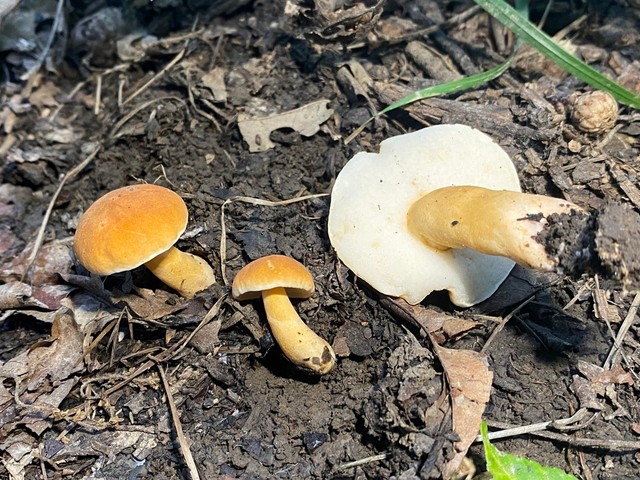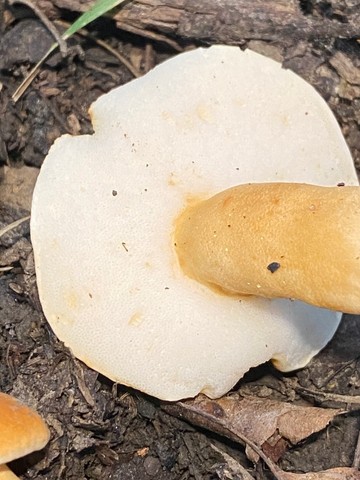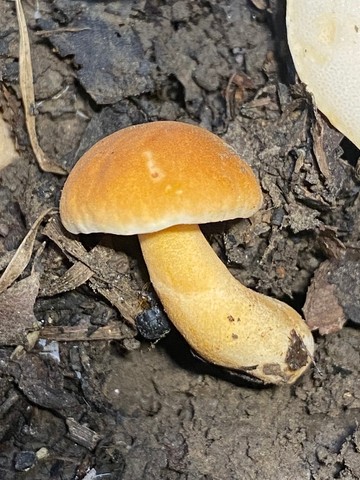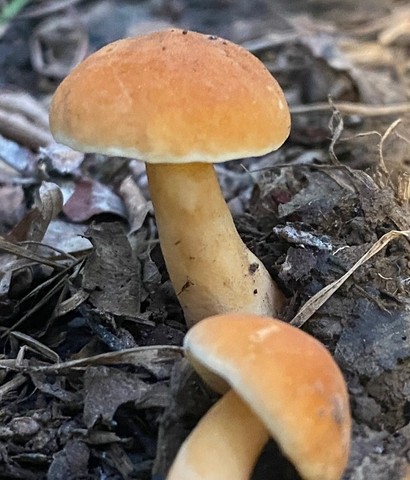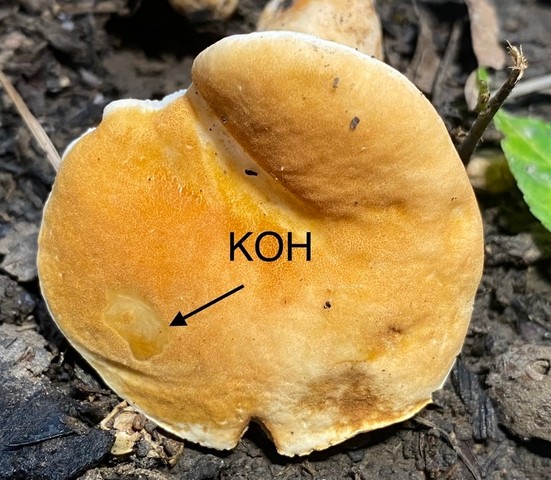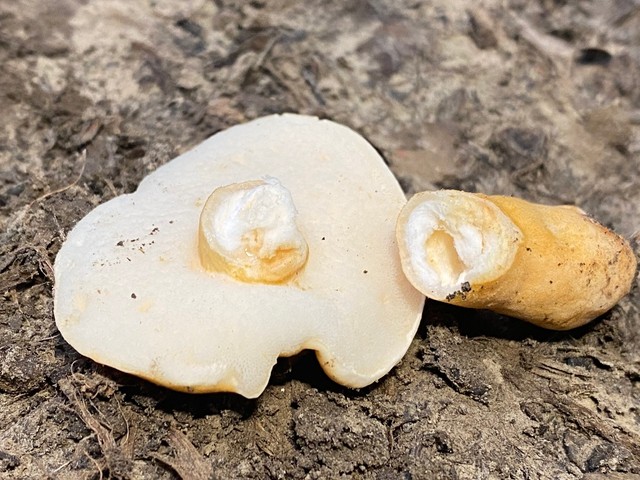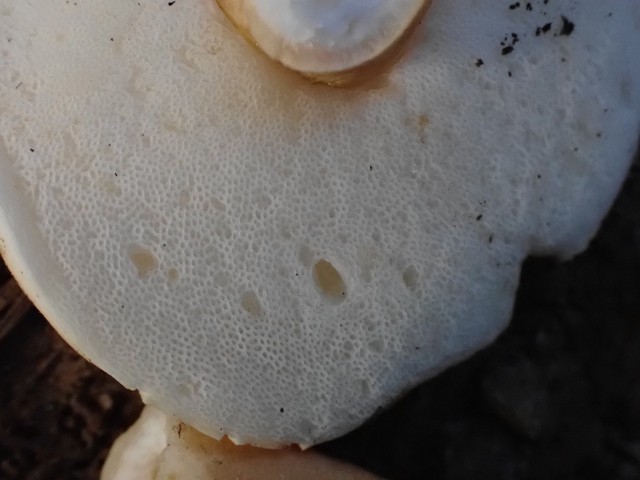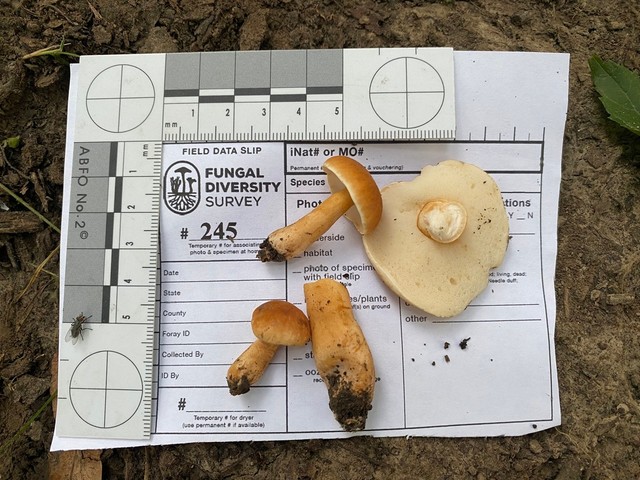Chestnut Bolete
Gyroporus castaneus-IN07
Life > Fungi > Basidiomycota > Agaricomycotina > Agaricomycetes > Agaricomycetidae > Boletales > Gyroporaceae > Gyroporus
The Chestnut Bolete (Gyroporus castaneus) is a mycorrhizal (and reportably saprobic) bolete that can be found in woodland soil and disturbed areas. Although boletes generally associate with a mycorrhizal host tree, this mushrooms has reportably been found in areas without a visible mycorrhizal symbiont. Otherwise, it has been associated with Oaks, other broadleaf trees, and conifers. It can be found growing alone or in small groups in July, August, and September in eastern North America.
2024 DNA results identified the survey specimen as Gyroporus "castaneus-IN07" suggesting it to be a genetically divergent species to Gyroporus castaneus in the strict sense. This cryptic name is a placeholder until it can be published formally.
The cap shape is evenly rounded, becoming flat with age. The flesh consistency is hard and brittle. It often splits at the margin at maturity. The cap texture is smooth to slightly velvety. The cap color features chestnut brown, yellowish brown, cinnamon brown to brownish orange.
The pore shape is circular to slightly angular. It is colored white to cream and doesn't bruise when handled:
The stem is brittle and becomes cottony hollow with age. It is colored similarly to the cap (concolorous), though sometimes paler.
Generally regarded as edible (Pavelle, 2025).
July 26th, 2023 Field Notes - Indian Cave State Park:
Growing gregariously near disturbed horse trail in open mixed oak/hickory woodland edge. Nearby Trees: Black Oak, Black Cherry, Chinkapin Oak, Elm, and Ash.
- Caps light brown, subtomentose and firm.
- Hymenium consisting of cream white circular pores that are unchanging when damaged.
- Stipe light brown similar to cap, with central pith and slightly exuding liquid where snapped.
- Flesh unchanging when bruised or cut.
- Smell: not distinctive.
- Taste: not distinctive.
DNA Barcode ITS: AAGTCGTAACAAGGTTTCCGTAGGTGAACCTGCGGAAGGATCATTAAGGGATAAAACGAAGGACCGTACGACCGAGTCGGTCTCGGTCATGTACGGTCCGGGTCGGTCTTTCCTGTGCACGCGTCGTAGGTCTTCGGGCCTACGTTCATACACCTCTCGGTGTTCGAACGTCCATGGACTGTGACCGCCCGACCGTCGTGTCGGGCGAGAACGCATAACTTTCAGCAACGGATCTCTTGGCTCTCGCATCGATGAAGGACGCAGCGAATCGCGATAAGTAATGTGAATTGCAGATCTTCCGTGAATCATCGAATCTTTGAACGCACCTTGCGCCCCTCGGTATTCCGAGGAGCATGCCTGTCTGAGTGTCTGGACTATACTCTCGGTTGCGAGATCCTTTCGGGGTATCGAAACCGGAATTTGGGAGCTTGCGGGCGTCCTCGGTCGAGGTGACGTCGGCTCTCCTGAAATGCATTAGCGGAGAGGAACGGCACCGAAGCCAAGCGATCGGAGCGCGACCTTTTCCCTCGGCGTCGTAAGGATCGCCGTGGGCTCGGGAAGCGTGAGCGAGGTTTTTCGGGGCATGACGTGTCTCACGCTGCTAGCACGGTCGGCGAGCCTCGGGCGTCGTCGGACACGTTTTCAGCACTCGGCCTCAGATCAGGCAGGGCTACCCGCTGAACTTAAG
References
Halling, R. E. (2024). Taxon Details: Gyroporus castaneus (Bull.:Fr.) Quél. The New York Botanical Garden. https://sweetgum.nybg.org/science/projects/boletineae/taxon-details/?irn=254298
Kuo, M. (2013, December). Gyroporus castaneus. Retrieved from the MushroomExpert.Com Web site: http://www.mushroomexpert.com/gyroporus_castaneus.html
Pavelle, S. (2015b, July 24). Gyroporus f/k/a castaneus (“Chestnut Bolete”). The Bolete Filter. https://boletes.wpamushroomclub.org/product/gyroporus-castaneus/
Quélet, Lucien. (1886). Enchiridion fungorum in Europa media et praesertim in Gallia vigentium (p. 161). O. Doin. https://www.biodiversitylibrary.org/page/32653197
Zeller, D. (2025, January). Nature Colors. Retrieved from beta site: https://naturecolors.netlify.app/
